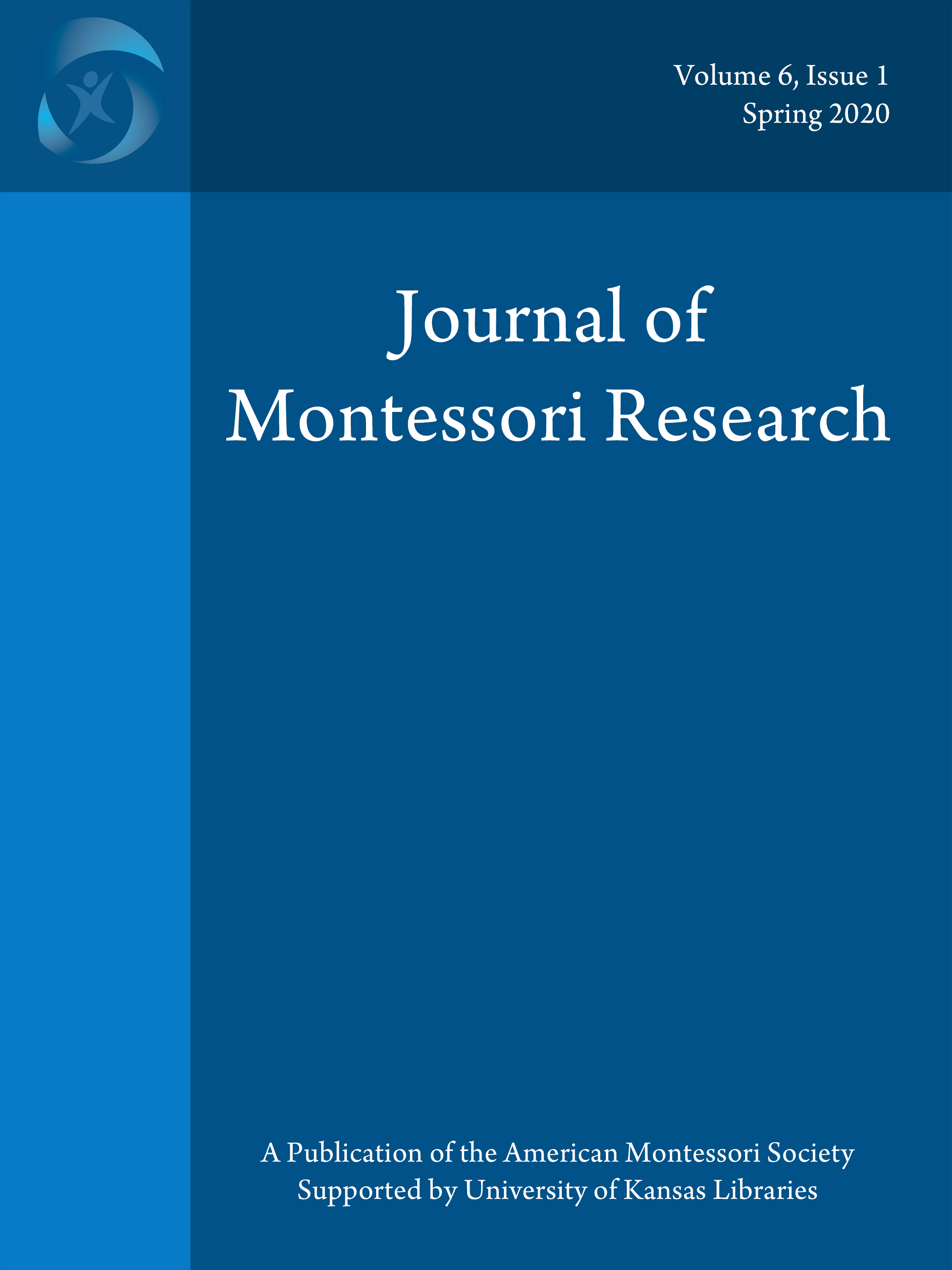Montessori Education and a Neighborhood School
A Case Study of Two Early Childhood Education Classrooms
DOI :
https://doi.org/10.17161/jomr.v6i1.8539Mots-clés :
curriculum, diversity, partnerships, early childhood educationRésumé
Project SYNC (Systems, Yoked through Nuanced Collaboration) details perspectives of a community of stakeholders committed to the enhancement of early childhood (i.e., prekindergarten through grade 3) education. Although there is a growing number of public-school programs informed by the Montessori philosophy, Montessori educational experiences often take place within affluent communities. SYNC aimed to enhance the prekindergarten through grade 3 educational experiences for traditionally underserved students by transforming two traditional early childhood classrooms to Montessori settings within a diverse, Title I school. Montessori pedagogy, curricula, and materials aligned with the school’s dedicated commitment to social justice. The study, one in a series, explored the impact of Montessori education on a neighborhood school community as evidenced through stakeholder opinions, project implementation, and teacher attitudes. Project data illustrate that a Montessori educational experience created learning opportunities that supported children from culturally and ethnically diverse communities in a traditional, Title I elementary school.
Références
American Montessori Society. (n.d.). About Montessori education. https://amshq.org/About-Montessori
Ansari, A., & Winsler, A. (2014). Montessori public school pre-K programs and the school readiness of low-income Black and Latino children. Journal of Educational Psychology, 106(4), 1066–1079. https://www.apa.org/pubs/journals/releases/edu-a0036799.pdf
Banks, K., & Maixner, R. A. (2016). Social justice education in an urban charter Montessori school. Journal of Montessori Research, 2(2), 1–14. https://doi.org/10.17161/jomr.v2i2.5066
Bouck, E. C. (2011). Exploring the enactment of functional curriculum in self-contained cross-categorical programs: A case study. In M. Lichtman (Ed.), Understanding and evaluating qualitative educational research (pp. 110–126). SAGE Publications.
Brown, K., & Lewis, C. W. (2017). A comparison of reading and math achievement for African American third grade students in Montessori and other magnet schools. Journal of Negro Education, 86(4), 439–448. https://www.jstor.org/stable/10.7709/jnegroeducation.86.4.0439
Brown, K. E., & Steele, A. S. L. (2015). Racial discipline disproportionality in Montessori and traditional public schools: A comparative study using the relative rate index. Journal of Montessori Research, 1(1), 14–27. https://doi.org/10.17161/jomr.v1i1.4941
Crocco, M. S., & Costigan, A. T. (2007). The narrowing of curriculum and pedagogy in the age of accountability: Urban educators speak out. Urban Education, 42(6), 512–535. https://doi.org/10.1177/0042085907304964
Culclasure, B., Fleming, D. J., Riga, G., & Sprogis, A. (2018). An evaluation of Montessori education in South Carolina’s public schools. The Riley Institute at Furman University. Unpublished manuscript. https://riley.furman.edu/sites/default/files/docs/MontessoriOverallResultsFINAL.pdf
Debs, M., & Brown, K. E. (2017). Students of color in public Montessori schools: A review of the literature. Journal of Montessori Research, 3(1), 1–15. https://doi.org/10.17161/jomr.v3i1.5859
Debs, M. C. (2016). Racial and economic diversity in U.S. public Montessori schools. Journal of Montessori Research, 2(2), 15–34. https://doi.org/10.17161/jomr.v2i2.5848
Johnson, R. B., & Christensen, L. (2014). Educational research: Quantitative, qualitative, and mixed approaches (Fifth edition). SAGE Publications.
Lillard, A. S. (2005). Montessori: The science behind the genius. Oxford University Press.
Lillard, A. S. (2012). Preschool children’s development in classic Montessori, supplemented Montessori, and conventional programs. Journal of School Psychology, 50(3), 379–401. https://doi.org/10.1016/j.jsp.2012.01.001
Lillard, A. S., & Heise, M. J. (2016). An intervention study: Removing supplemented materials from Montessori classrooms associated with better child outcomes. Journal of Montessori Research, 2(1), 16–26. https://doi.org/10.17161/jomr.v2i1.5678
Lillard, A. S., Heise, M. J., Richey, E. M., Tong, X., Hart, A., & Bray, P. M. (2017). Montessori preschool elevates and equalizes child outcomes: A longitudinal study. Frontiers in Psychology, 8, 1783. https://doi.org/10.3389/fpsyg.2017.01783
Manner, J. C. (2007). Montessori vs. traditional education in the public sector: Seeking appropriate comparisons of academic achievement (EJ1099115). Forum on Public Policy Online, 2, 1–20. ERIC. https://files.eric.ed.gov/fulltext/EJ1099115.pdf
Marshall, C. (2017). Montessori education: A review of the evidence base. Science of Learning, 2(11), 1–9. https://doi.org/10.1038/s41539-017-0012-7
Mathews, J. (2007, January 2). Montessori, now 100, goes mainstream. The Washington Post. https://www.washingtonpost.com/archive/local/2007/01/02/montessori-now-100-goes-mainstream-span-classbankheadonce-considered-radical-and-elitist-method-creeping-into-public-schoolsspan
Merriam, S. B. (1988). Case study research in education: A qualitative approach. Jossey-Bass.
Merriam, S. B., & Tisdell, E. J. (2016). Qualitative research: A guide to design and implementation (4th ed.). John Wiley & Sons.
Miles, M. B., & Huberman, A. M. (1994). Qualitative data analysis: An expanded source book. SAGE Publications.
Moody, M. J., & Riga, G. (2011). Montessori: Education for life. In L. Howell, C. W. Lewis, & N. Carter (Eds.), Yes we can! Improving urban schools through innovative education reform (pp. 127–143). Information Age Publishing.
Musu-Gillette, L., de Brey, C., McFarland, J., Hussar, W., Sonnenberg, W., & Wilkinson-Flicker, S. (2017). Status and trends in the education of racial and ethnic groups 2017 (NCES 2017-051). U.S. Department of Education, National Center for Education Statistics. https://nces.ed.gov/pubs2017/2017051.pdf
Neuman, W. L. (2003). Social research methods: Qualitative and quantitative approaches (5th ed.). Pearson Education.
Orfield, G., Kucsera, J., & Siegel-Hawley, G. (2012). E pluribus . . . separation: Deepening double segregation for more students. UCLA Civil Rights Project. https://civilrightsproject.ucla.edu/research/k-12-education/integration-and-diversity/mlk-national/e-pluribus...separation-deepening-double-segregation-for-more-students/orfield_epluribus_revised_omplete_2012.pdf
Rodriguez, L., Irby, B. J., Brown, G., Lara-Alecio, R., & Galoway, M. M. (2005). An analysis of second grade reading achievement related to pre-kindergarten Montessori and transitional bilingual education. National Association of Bilingual Education. In V. Gonzalez & T. Tinajero (Eds.), NABE review of research and practice (Vol. 3, pp. 45–65). Lawrence Erlbaum Associates.
Schonleber, N. S. (2011). Hawaiian culture-based education and the Montessori approach: Overlapping teaching practices, values, and worldview. Journal of American Indian Education, 50(3), 5–25. https://www.jstor.org/stable/43608610
Solórzano, R. W. (2008). High stakes testing: Issues, implications, and remedies for English language learners. Review of Educational Research, 78(2), 260–329. https://doi.org/10.3102/0034654308317845
Tozier, J. (1911). An educational wonder-worker: The methods of Maria Montessori. McClure’s Magazine, 37(1), 3–19.
Vaughan, D. (1992). Theory elaboration: The heuristics of case analysis. In C. Ragin & H. Becker (Eds.), What is a case? Exploring the foundations of social inquiry (pp. 173–202). Cambridge University Press.
Wohlstetter, P. (2016, April 8–12).“Intentionally diverse” charter: Inside schools. Paper presented at the annual meeting of the American Educational Research Association, Washington, DC.


